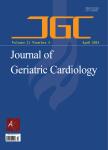Invasive versus conservative strategy in consecutive patients aged 80 years or older with non-ST-segment elevation myocardial infarction: a retrospective study in China
Invasive versus conservative strategy in consecutive patients aged 80 years or older with non-ST-segment elevation myocardial infarction: a retrospective study in China作者机构:Department of Cardiology Fuwai Hospital National Center for Cardiovascular Diseases Chinese Academy of Medical Sciences and Peking Union Medical College
出 版 物:《Journal of Geriatric Cardiology》 (老年心脏病学杂志(英文版))
年 卷 期:2019年第16卷第10期
页 面:741-748页
核心收录:
主 题:Conservative strategy Death Invasive strategy Non-ST-segment elevation myocardial infarction
摘 要:Objective To investigate whether the very elderly patients with non-ST-segment elevation myocardial infarction (NSTEMI) will benefit from an invasive strategy versus a conservative strategy. Methods 190 consecutive patients aged 80 years or older with NSTEMI were included in the retrospective study from September 2014 to August 2017, of which 69 patients received conservative strategy and 121 patients received invasive strategy. The primary outcome was death. Multivariate Cox regression models were used to assess the statistical association between strategies and mortality. The survival probability was further analyzed. Results The primary outcome occurred in 17.4% patients in the invasive group and in 42.0% patients in the conservative group (P = 0.0002). The readmission rate in the invasive group (14.9%) was higher than that in the conservative group (7.2%). Creatinine level (OR = 1.01, 95% CI: 0.10–1.03, P = 0.05) and use of diuretic (OR = 3.65, 95% CI: 1.56–8.53, P = 0.003) were independent influential factors for invasive strategy. HRs for multivariate Cox regression models were 3.45 (95% CI: 1.77–6.75, P = 0.0003), 3.02 (95% CI: 1.52–6.01, P = 0.0017), 2.93 (95% CI: 1. 46–5.86, P = 0.0024) and 2.47 (95% CI: 1.20–5.07, P = 0.0137). Compared with the patients received invasive strategy, the conservative group had remarkably reduced survival probability with time since treatment (P 0.001). Conclusions An invasive strategy is superior to a conservative strategy in reducing mortality of patients aged 80 years or older with NSTEMI. Our results suggest that an invasive strategy is more suitable for the very elderly patients with NSTEMI in China.



